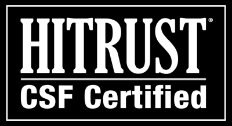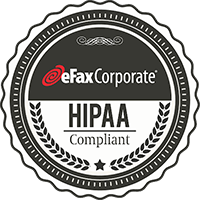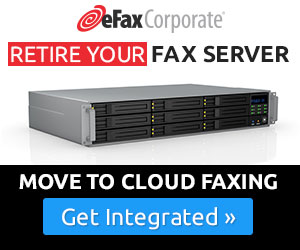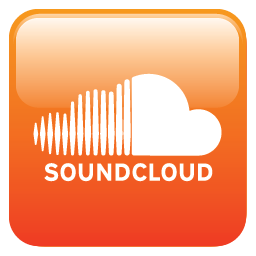5 Ways to Cloud Fax That You Might Not Know About
When we say “cloud fax” or “move your business fax infrastructure online,” what do we mean, exactly?
We at eFax Corporate use these terms often — along with many similar ones like “fax online,” “fax by email,” “Internet fax” and “fax through the cloud.”
….And we realize that if you’re new to the concept of leveraging the Internet for faxing, you might not have a clear technological understanding of how this works.
Even if you’ve had limited exposure to the concept of cloud faxing, chances are you’re familiar with it as a technology that lets you send and receive faxes using your email program. Which is accurate — but far from the whole story.
Email is only one of several ways businesses can upgrade their legacy fax infrastructure from fax machines and in-house fax servers to a fully outsourced and hosted cloud fax model.
Indeed, one of the reasons to migrate your fax processes to the cloud is that cloud faxing offers such a flexible array of options. If outsourced properly, it can allow your IT team to deploy just the right faxing services and protocols to save your business money, leverage your existing IT infrastructure, and make your employees more productive.
So for this post, we thought we’d take a step back and discuss the basics. First, we’ll explain how cloud faxing works, using the familiar email method to show you the technology behind it. Then we’ll tell you about several other ways you can leverage cloud technology to streamline and improve your fax infrastructure.
How Cloud Faxing Works: The Fax-by-Email Model
When you sign up for a cloud fax service, your provider will assign your business a virtual fax number — or several, depending on your company’s size, locations and needs. Some businesses want just one fax number.
Others require direct fax numbers for each department or each geographical location. Still others want every employee to have a unique fax number. With the right cloud fax provider, you will be able to set up as many fax numbers as you need — and scale up or down anytime.
These are in fact real fax numbers, with your choice of local or toll-free area code, and a standard 7-digit number.
Once you have your business’s virtual fax numbers set up, you can then use them to fax electronically — through the Internet, and without the need for fax machines or fax servers — in any of the ways we’re about to discuss.
And here’s a very brief overview of the technological behind-the-scenes. Let’s say your IT team decides to allow your employees to use their corporate email to send and receive faxes.
(Keep in mind this example is for illustrative purposes only; your business will have many methods of cloud faxing in addition to email. And the transmission technology will be largely the same as we’ll describe here.)
Once you have your virtual fax numbers set up, your provider will give you a standard email convention for sending faxes. This is usually the recipient’s fax number followed by an email convention the provider gives you. As an eFax Corporate customer, for example, you would enter the recipient’s fax number followed by @efaxsend.com
To send a fax, you’d just open a new email message in your standard email program. In the To field, you’d enter something that looked like this: [email protected]
From here your options would vary depending on the cloud fax provider. But you should at minimum be able to create a custom cover page by typing it into the email body, or by pulling in a pre-existing template or cover page from your hard drive or your provider’s library of customizable covers.
Then you should be able to attach several documents (ideally in any file format), either from your hard drive or from cloud storage, just as you would attach them to a standard email.
When you hit Send, your outbound email would be intercepted by your cloud fax provider, where they would then immediately convert the entire package — any cover page message you’ve included in the body, plus all of the file attachments, in order — into a single PDF, which they would then transmit via the Internet, and finally deliver to your recipient’s fax machine or server.
When the fax has been delivered successfully, the cloud fax provider would then email you a delivery confirmation notice. This confirmation should also be automatically logged in your account and accessible anytime through your administrator portal, for record keeping and audit purposes.
For receiving faxes, your cloud fax provider would perform a similar function in reverse. That is, the inbound fax being sent to you would be automatically delivered to your provider, who would then convert the analog fax image to a PDF (or a TIFF, if you prefer), and then forward the converted file to your email address as an attachment.
Some of the better providers, by the way, will give you additional options for added layers of security if your business needs them for receiving faxes. For example, some will let your company opt to not have the inbound faxes emailed directly to the recipient but rather held on a secure, encrypted website, to which only your intended recipients or administrators would have access.
It’s also important to point out here that whether the other party is sending you a fax at your virtual fax number, or receiving a fax from your business, it will appear to them as though you’re using a standard fax server or desktop fax machine. That’s because your business’s fax number will appear just as it would if you were, in fact, using an old-fashioned fax machine and an analog fax landline. The people and businesses who do business with your company won’t know that you’re in fact faxing through the cloud.
5 Ways to Cloud Fax That You Might Not Know About
Now that we’ve reviewed the very basics of how a cloud fax service would work for your business, let’s review some of the flexible options you and your staff will have for integrating faxing into your document workflow — in addition to sending and receiving your faxes through email.

1. Fax online through a secure portal
Most cloud fax services will also provide a web interface from which your employees would be able to send, receive, view and forward faxes, as well as search for your archived faxes.
What’s great about these online fax portals is that even if your employees can’t get to their corporate email, they can still send and receive business faxes right through the on-line cloud fax account, as long as they have access to the Internet.
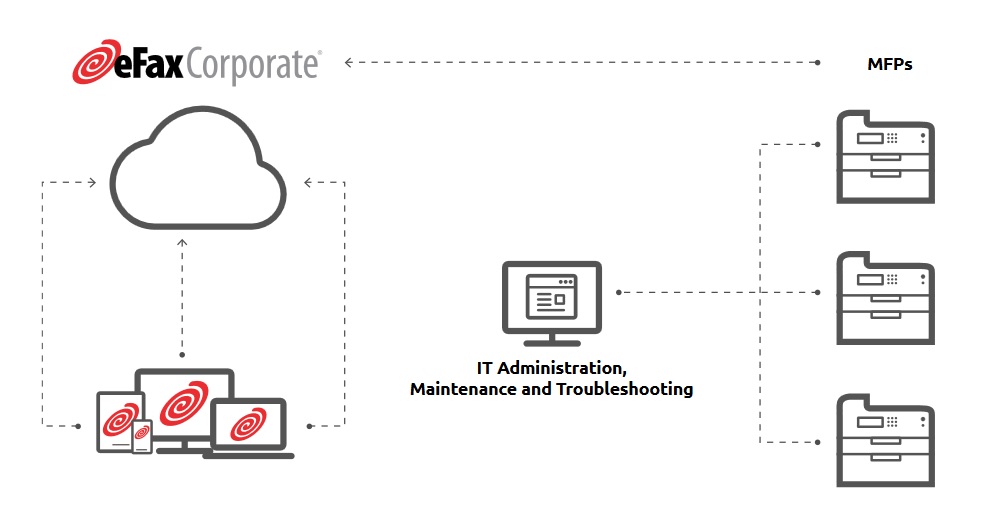
2. Cloud fax from your multifunction printers
The ability to integrate cloud fax capability into your standard office multifunction printers (MFPs) is a feature offered by the better cloud fax providers. In other words, if your employees need to send a fax with a “wet ink” signature, say when a signature is required on a service contract, they can place the document right onto the glass of your MFP, and then use the control panel to send the fax just as they would send an email from the device.
And because the fax would be sent through your cloud fax account, a detailed record of it would automatically be added to your overall fax usage for record keeping and audit purposes.
Now faxing from MFPs is nothing new; many have a scan/fax button right on the control panel. But those needed to be hooked up to a costly telephone line in order to send faxes, and those lines can currently cost $50 a month or more, and you would need one for each device. With a cloud fax service, need for a dedicated fax line is eliminated, because the MFP is connected to the Internet through the company’s local area network.
This means your company would be able to extend the value of the MFPs you’ve invested in, streamline your employees’ fax processes, and —perhaps most important — continue to enjoy all of the value of faxing from your MFPs while eliminating the costly analog fax line it currently requires.
Learn more about MFP integration with cloud fax
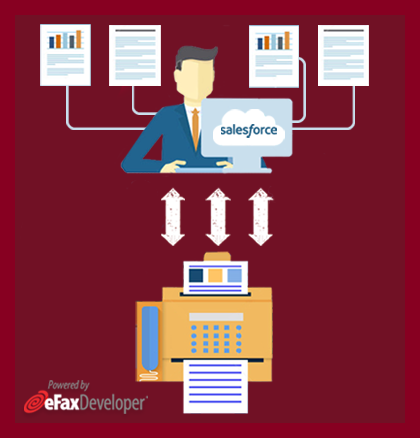
3. Integrate cloud faxing into your CRM and other workflow tools
Yet another powerful way to streamline your company’s faxing and boost staff productivity is by embedding cloud fax capability right into the workflow applications your employees use every day — such as their Customer Relationship Management (CRM) applications like Salesforce.com.
You can do this with minimal effort if you partner with the right cloud fax providers — because they will provide you an API that lets you easily integrate your cloud fax capability into any CRM, ERP or other critical business application. What’s more, the best fax APIs can work with virtually any language: C++, Java, .NET, Python, etc.
If your employees frequently generate documents in CRM tools or, in the case of healthcare companies, Electronic Health Records (EHR), that then need to be faxed, this integration can save a tremendous amount of time and effort. With a fax API embedding cloud fax capability directly into your Salesforce or EHR application, for example, your staff could fax the needed materials natively, from within the application, rather than having to print, scan or otherwise output the document first and then send the fax.
Also, because the fax API would be tied specifically to your company’s cloud fax account, all of this activity of faxing through your CRM or other workflow tools would also be recorded in your account and available in your usage reports, to help your IT team better track overall fax activity and maintain compliance with record keeping and audit requirements.
Learn how to use a cloud fax API to integrate faxing into your workflow

4. Integrate cloud faxing into your SAP applications
If your business uses enterprise resource management (ERM) system based on software from SAP, here is another way to extend the value of your internet fax service — and streamline your employees’ workflow.
As an SAP-certified fax partner, we can enable your organization to fax directly from within the SAP environment your employees use every day. Our solution, SAP Fax Connector, will natively output your faxes as SMTP (email) messages that travel securely across the Internet, directly to eFax, where we convert and process them to for delivery to your fax recipients.
Again, we help your staff remove several steps in the faxing process — by letting them create and send the important business fax documents they generate in their SAP sessions without ever having to leave their SAP environment.
Watch our free webinar on SAP integration with cloud faxing

5. Cloud fax directly and securely from your mobile devices
If your employees are widely distributed, work remotely, or are frequently on the road conducting business, another layer of cloud fax flexibility available from the better providers is through a mobile application.
With the more sophisticated mobile fax apps, your provider will distill the key functionality of your company’s cloud fax service to an intuitive, convenient and secure interface that lets your employees receive, view, annotate, save, forward and send faxes right from their smartphone or tablet.
No need to run around looking for a store or hotel that offers fax service. Faxing can happen anytime and virtually anywhere within range of a cell phone tower.
Learn about cloud faxing from a mobile app
All these layers of versatility is just one reason that a cloud fax solution is preferred by the majority of Fortune 500 corporations. As a pioneer in faxing for 20 years, eFax Corporate offers all of these and other powerful tools to allow our customers to send and receive faxes using the methods and technologies that are most beneficial to them.
If you have any questions regarding cloud faxing, HIPAA Faxing Regulations or Federal Compliancy for fax usage, please contact an eFax Corporate representative today.
Learn more about the eFax Corporate’s wide range of cloud fax solutions.


